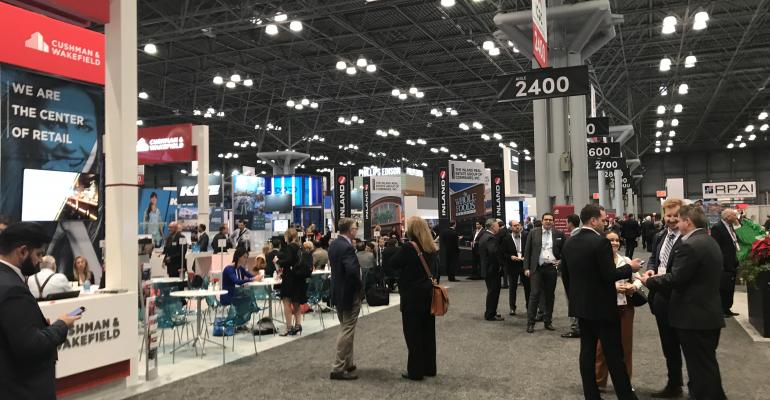At the first day of the International Council of Shopping Centers’ New York Deal Making conference, held at the Jacob K. Javits Convention Center in Manhattan, attendees tried to emphasize the bright side in a sector that’s faced challenges of late. Although retail real estate is facing disruptions—and many believe the country is over-retailed—industry leaders at the event said these challenges ultimately provide opportunities for growth.
“I think last year a lot of people were a little unsure of the future, but I think the year has shown that retail is here to stay,” said Jeremy Schwartz, a senior associate of retail services at Avison Young, a commercial real estate services firm.
Here are six key points industry leaders at the first day of the event, along with a slideshow with scenes of the conference floor.
- Grocers need to adapt—now. Internet delivery has not yet had a major impact on the supermarket sector, says Jeffery Edison, CEO and president of Phillips Edison & Co., which owns on grocery-anchored shopping centers. “Our occupancy level is the highest level it’s ever been in the 25 years we’ve had the portfolio,” Edison says. However, that does not mean that grocers do not need to be prepared. The grocers that will succeed will be those that will be able to have a plan, such as adding services to allow consumers to buy online and pick up in store. “You really have to be addressing it now,” he says.
- Technology can help with tenant selection. Real estate services firm JLL is incorporating new geofencing technology to allow it to track customers not only while they are shopping within a mall, but also outside of it. On Thursday, the firm announced the launch of PinPoint, which is a new geofencing software tool that analyzes data scraped from cellphones and GPS to monitor which consumers enter geofences—virtual boundaries of sorts—and how long they stay. The data can help mall owners determine where consumers are going—and if those places are potential tenants. “All of a sudden that triggers—we need more restaurants, or we need more sporting goods. There’s so much data and there’s so many ways you can use it,” says Holly Rome, executive vice president, director of national leasing at JLL.
- Retailers are learning more about real estate—and landlords about retail. Thomas Londres, president and CEO of Metro Commercial, a retail real estate firm, says he has noticed a shift in negotiations: Retailers are coming to the table with more requirements and restrictions in an effort to protect their uncertain futures. Meanwhile, landlords are trying to get a grasp on how their properties can help their tenants sell more online—whether it’s through adding more storage space or lockers on-site—and if they need more online-focused tenants like fulfillment centers. “The world is becoming very, very territorial,” Londres says.
- For grocery-anchored shopping centers, price discovery is becoming a question. There is no clear price discovery in some retail sectors like malls and power centers, into which there is little capital flow, Edison says. To date, the firm is seeing strong capital flows into the grocery-anchored market, but the question remains if that will change as pricing changes in other retail groups. “What we’re trying to figure out exactly is where pricing is today in the grocery-anchored business, because it’s moving in those other businesses pretty dramatically,” he says.
- Some investors are eyeing non-coastal areas of the U.S. for opportunities. While the coast continues to do well, but there also appears to be increasing investor appetite in the U.S. “fly-over” states, where there may be more attractive pricing, particularly for opportunistic, value buyers, says Mark Hunter, managing director of retail asset services at CBRE. The institutional buyer pool and private buyer pool tend to seek core assets in major urban markets, which are primarily along the East and West Coast. “In the middle of the country, there’s less demand, so I think there’s a tendency to have more attractive pricing,” Hunter says.
- Venture capitalists are funding more pop-up shops—to landlords’ relief. Venture capitalists and groups are funding pop-ups, which allows a third-party promotor to work with a landlord to get a new, unknown brand into a property, while the new brand can work on their business, says Anjee Solanki, national director of retail services at Colliers International. “I think that pop-up/retail is garnering more strength and credibility, which I think this great,” Solanki says. “It’s nice to see that there’s someone else willing to take the fall for rent … to guarantee their leases, which we haven’t seen in the past.”

